PLA filament is one of the most popular and widely used materials nowadays thanks to its qualities. However, if you are a newbie in this field, you may wonder if does PLA need a dry box.
In this post, we talked about how to keep PLA filament in the right way.
Moreover, we discussed how external factors can affect it and ways to prevent it.
Let’s take a look!
Related:
- How Much Does Jewelry Laser Engraving Machine Cost?
- How To Buy 3d Printed House? Complete Guide
- Are 3d Printed Phone Cases Good? Make Your Own Accessories
- How To Make Money With A Cheap 3d Printer? Complete Guide
Does PLA Need Dry Boxes?
Yes, it does, but not really necessary.
In fact, it is not a good idea to leave open spools of filament out in the open to deal with the weather on their own.
You should store it in a cold, preferably dark, dry location.
This ensures that 3D prints from an old filament turn out as well as they did when it was new.
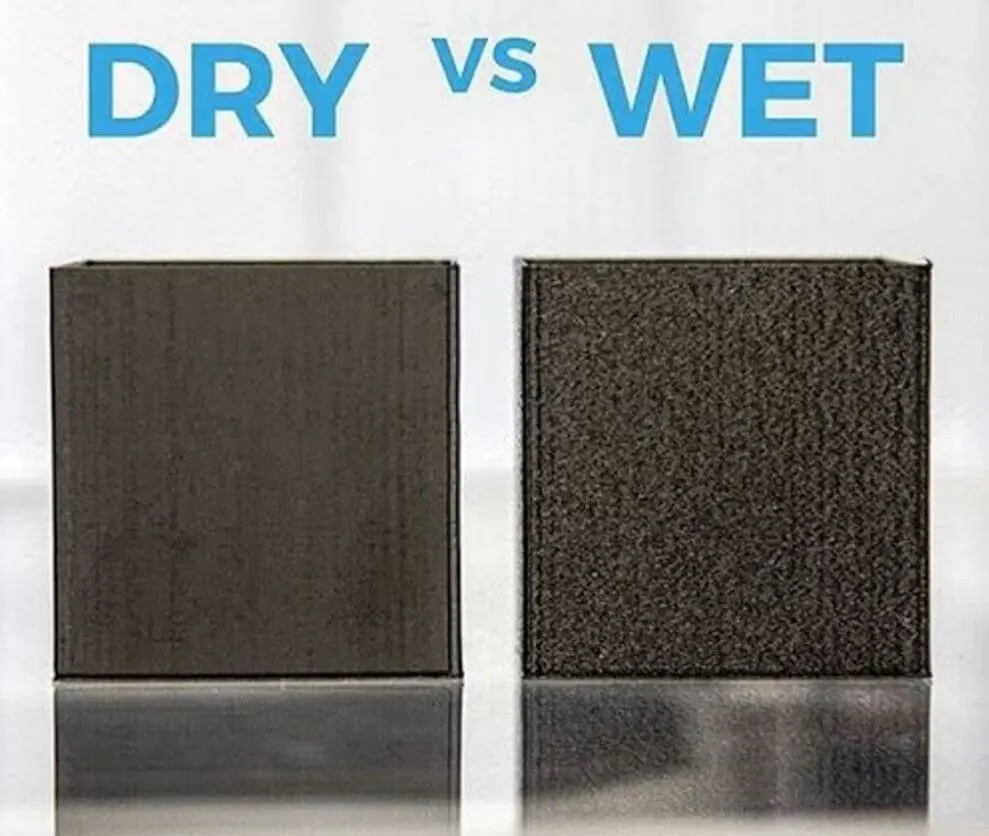
Sign of a wet filament (Source: All3DP)
You will want to keep your filament dry for as long as possible now that it is dry.
You have to keep the dry spools in a humidity-controlled environment to achieve this.
From an airtight box with desiccant packs to special business solutions, this can be anything.
The former is probably preferable, but use whatever suits your needs.
Keep in mind that good storage will not be able to dry filament for you; it will only be able to keep it.
If it becomes wet again, there are many tips to re-dry you can find on the internet.
You can still make a DIY box at home, but they typically lack utility and are inconvenient.
On the other hand, you can buy them on online stores at affordable prices:
In case you still want to try to make a filament dry box, watch this tutorial video from Thomas Sanladerer: (103) How to keep your filament dry: Make a storage box!
What Will Happen When My Materials Get Wet?
Signs that your filament is wet:
- When extruding, there are popping or cracking sounds.
- Part strength and layer adhesion have been severely reduced.
- Extrusion lines that are uneven
- Stringing, blobbing, or oozing is very severe
- Surfaces on prints that are highly rough or “fuzzy.”

Moisture trapped within the material can have an effect on color, durability, and finish.
The finish may appear dull, the color may appear with spots or smears, the structure may lose resilience and brittleness due to bubbles or holes generated when the filament is heated, and the color may appear with spots or smears.
Moisture also easily leads to bacteria.
Different types of filaments go bad at different rates, but the negative effect moisture has on each type is consistent.
PLA absorbs water and weakens slightly as a result.
It becomes weaker as it takes more moisture.
Wet prints feature a rougher texture and more flaws, such as blobs, bubbly texture, and stringing.
It will become more brittle and less flexible, making it more prone to break and less likely to bend. This will also affect the adhesion between the print’s layer mask.
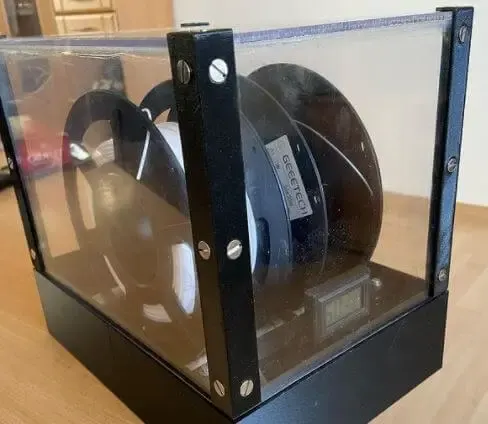
This is also why you should avoid printing with spools that have been sitting in a humid environment. Or else, it will damage the whole printing task and make the results much worse.
How Long Do 3D Printing Materials Generally Last?
Does PLA need a dry box? Yes, you may expect your filament to keep its qualities for at least two years if you store it in a dry, fairly cold place and kept in its packaging to prevent moisture.
This is true for a lot of common plastic, such as PLA, ABS, and PETG.
Nylon is an exception to this rule, as it generally stops working after 12 months on the shelf.
Keep in mind that the filament’s printing quality can last much longer than two years, so you will have to test it to see.
In general, avoid purchasing filament spools that have been sitting on a shelf for two or more years.
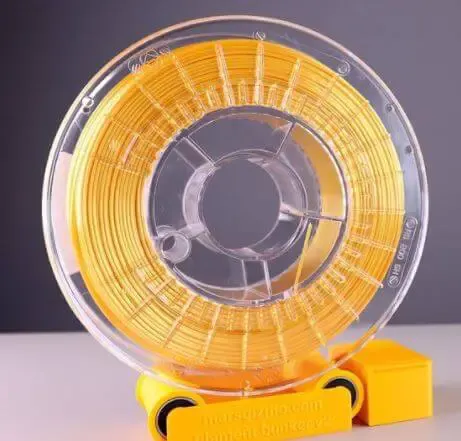
Regardless, there are far too many factors to consider, making it nearly impossible to tell how long a given spool will last.
A lot of factors can affect their lifespan, including the area you place them in, exposure to sunshine, temperature, and humidity, as well as their initial quality and kind.
PLA: This filament has a shelf life of about 2-3 years in most cases.
This means you can buy it, store it in its original packing in a cold, dry, and dark area (to avoid moisture), and print with it almost three years later.
Keep in mind that the print quality may begin to degrade after two years.
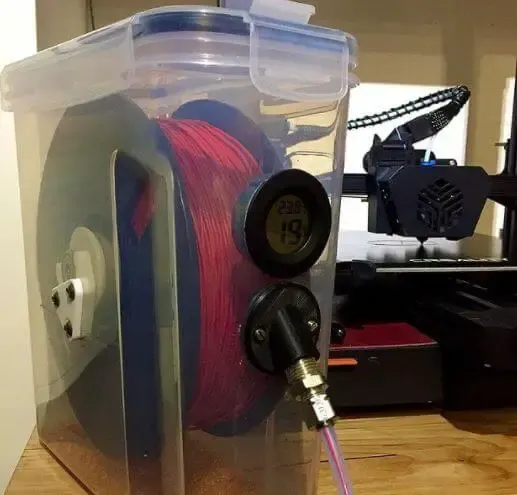
It can last for a long time before it became brittle and showing signs of wear but avoid PLA spools that have been stored in a hot garage or in the sun because it does not like heat or UV light.
On the other hand, you can store it indoors at room temperature for so many years without losing quality.
What Else Can You Use To Store Your Filaments?
Does PLA need a dry box? Yes, it does. But as we said above, this is not necessary.
If you can not find one at the moment, you can try different ways to keep your spools.
Remember that the key is not to let them expose to the external environment.
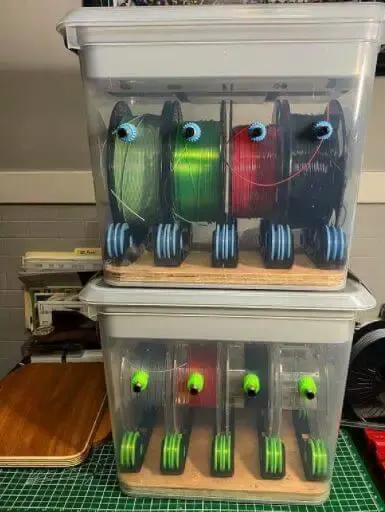
1 – Vacuum bag
You can buy an expensive plastic casing for each spool, make an anti-humidity box on your roof to protect your filament from moisture, or just buy a vacuum-sealed bag.
You know, the ones you see on ads where you can store all of your seasonal items to save space in your home?
Why do you need to use vacuum-sealed bags? They keep moisture, smells, mildew, and bugs away from your costly filament.
Remember that these aren’t Ziploc bags (bags that simply seal at the top). They do not always get rid of all the moisture.
To ensure that all of the life-saving oxygen is taken from the bag, look for the ones with a vacuum cleaner opening.
2 – Normal storage container
Transparent storage boxes with sealed lids are another good option for properly storing 3D printing spools.
The idea behind the sealed lids is that no new water from the outside can get inside.
Transparency is also a must, from the point of reality.
You will never know how is your spool in those boxes if you can not look inside them.
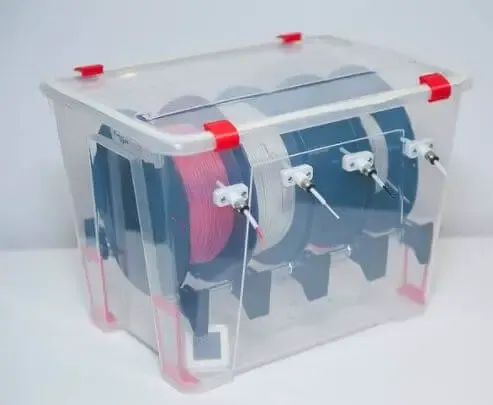
In terms of size, you may want something large enough to stack a few spools with a diameter of at least 20 cm.
A good starting point is something with a length of 40 cm and a width of 30 cm.
The height will vary depending on how many filament spools you wish to stack, but it should be around 40 cm.
3 – Silica gel
If you are working with PLA filament, silica gel packs are a must-have.
They may even be included when you buy extra filament, so keep them safe.
Why? As we already said, PLA absorbs far more water than ABS. Do not get us wrong: both ABS and PLA absorb water, so use these packs for both.
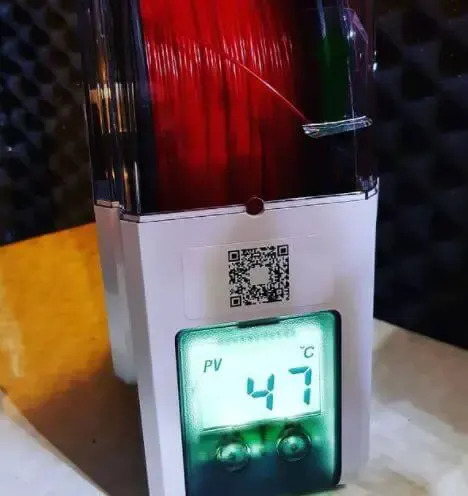
These gel packs come in a variety of shapes and sizes, and some of them can be reused after being dried in the oven.
These, and other similar packs, are not always the best because you can not tell when they have been saturated.
If you want to dry out, silica gel packs with moisture saturation indicators may be a better choice.
These go from yellow/orange to green to blue in color (depending on the moisture level).
Just put them in Ziploc bags, Tupperware, or any other box that will not let air in.
Keep in mind that, depending on the filament, storing filament for more than 12 months can lead to moisture absorption.
The best option is to buy only what you require and to use it all within a few weeks or months.
Does PLA Need A Dry Box: How To Dry Filaments? (filament dry)
1 – Kitchen oven
The most common way is using your oven.
We already said that adding heat when drying PLA is a bad idea.
However, if you have the correct tools, it is not impossible.
To begin, you will need a high-quality oven with the right settings that can reach temperatures as low as 40 to 50 oC.
Although this is about 20 degrees below its glass transition range, the “low and slow” method of drying is the safer option for avoiding a fused mess.
You should be able to keep the spool in the oven for four to six hours if you can set it to this low of a temperature.
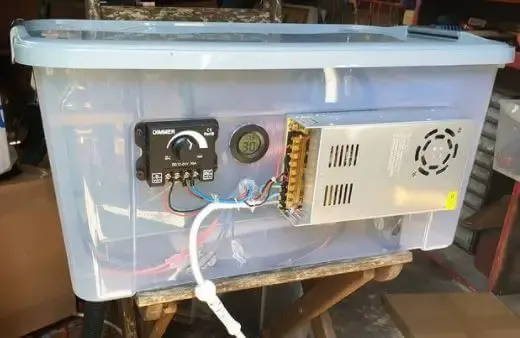
Before you start doing, make sure that your oven hits the temperature that you set it to.
A simple change from the set level is fine, but a difference of more than 10 oC could be risky.
Set your oven to the right range and place the right calibrated temperature inside to check if it is right or not.
Without opening the oven, you must be able to view the temperature value.
You can also use this test to assess how long the oven will need to warm up before it reaches a stable level.
2 – Dehumidifiers
On sites like Amazon, you can find a nice dehumidifier for as low as $15 to $20.
About once a month, these products must be recharged.
Simply plug them into a power outlet when the silica gel beads change color to renew them.
Most dehumidifiers have a color indicator that lets you know when it’s time to replace it.
Silica gel beads, like vacuum bags, are used to collect moisture.
Because each box can only hold around 5 or 6 spools, most people should be able to get by with two storage boxes and two dryers. That initial cost is offset by the fact that your tool is renewable.
Simply place the product inside the storage box with the sign facing outside when you are sure it is completely charged.
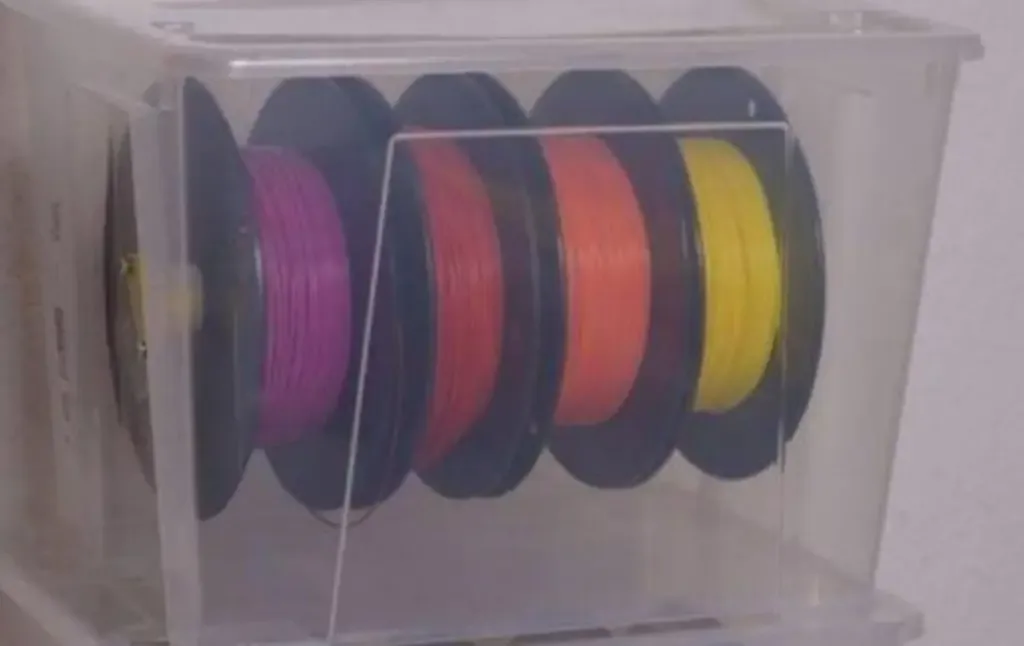
Dehumidifier setting for spool storage (Source: 3D Printing)
Does PLA Need A Dry Box? Frequently Asked Questions
1 – What Is A Dry Box? (filament drying)
It is a type of storage box that can come in a variety of shapes and sizes.
Normal plastic dry boxes for tools and other items, desiccant ones for laboratory tools storage, and electronic ones for expensive things or materials that must be kept dry at all times.
A dry box is designed to keep objects dry, as the name says.
However, there are ones that are made for a certain type of thing.
2 – Do I Really Need To Use Containers For Filaments?
Leaving these materials out in the open exposes them to external factors, which can be harmful.
Small particles in the air cause poor printing quality and, as a result, a poor product.
We also do not recommend you clean or replace the printer’s nozzle during the printing process.
So, if you buy good storage, it will reduce waste and saves your money as well as resources.
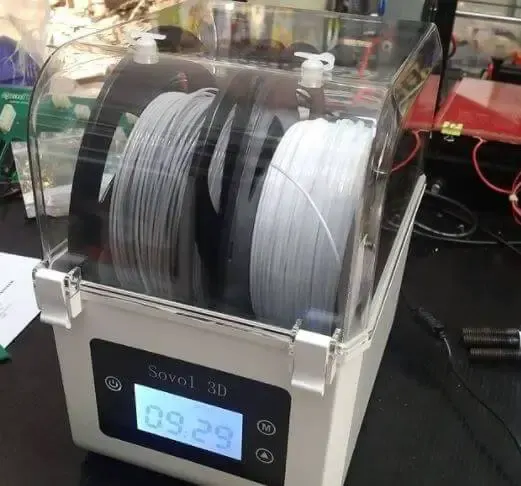
3 – How Long Does PLA Filament Last In The Open?
The expiry date of PLA spools stored in an exposed condition might range from one month to two years.
Although it is not water-soluble, it has a high water absorption rate.
4 – Can I Wash PLA With Water?
PLA absorbs water, creating volumetric expansion when water molecules spread between polymer chains.
Pure water will have no effect on PLA in any other way.
5 – Should I Remove PLA After Printing?
Because some filaments absorb moisture, they must be stored away from moisture.
As a result of the extreme heat that the filament needs to take, they do not print well.
It is possible that the filament will grow brittle, but it is not really dangerous to keep it out there.
Conclusion
We hope after reading our article, you can understand how to keep your filament in the right way. Storing filaments dry is very important because it can affect the whole printing process, as long as the final result.
In summary, does PLA need a dry box? A dry box is a tool, but if you can not find one, you can still use other ways to keep your spools. As long as you can make sure that the materials are not exposed too long in the open air.
Further Reading:
- Best Creality 3d Printer– How To Choose The Best One?
- Best Filament For Ender 3
- Top 6 Best 3D Printer For Cosplay Armor
- Best 3d Printer For Board Games
- Best Filament For Lithophanes: What To Use
- Top 7 Best Dual Extruder 3d Printer Under $500
Tags: dry box, it is not totally necessary to store pla filament in a dry box, suggests that pla doesn’t need to be dried, a dry box m,ay not be, are practically useless unless dried, dried, filament drying, printing materials, printing process, dry filaments, filament storage, printing filament, dry filament, answer, food dehydrator, dehydrator, follow, filament dryer, share, support, printers, question, comments, weight, degradation.
